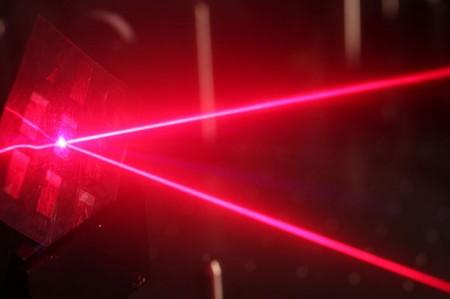 A laser being used to understand why plastic solar cells are efficient. (Credit: Dimali
A laser being used to understand why plastic solar cells are efficient. (Credit: Dimali Amarasinghe, Gordon Hedley / University of St Andrews)
Scientists at the University of St Andrews have found out that fiber-like structures (arrangements of molecules) are responsible for making some materials more efficient at converting the sun’s light into electricity than others.
A new discovery by Professor Ifor Samuel and Dr Gordon Hedley of the School of Physics and Astronomy could improve how coatings on windows, or on curved or flexible surfaces, work to convert solar energy into electricity.
Plastic solar cells offer the prospect of simple fabrication and hence low cost, but their efficiency needs to be improved. They are typically made by blending two materials together.
Using a combination of sophisticated laser measurements and very high resolution microscopy, the team were able to see the differences between a highly efficient and a less efficient solar cell.
They found that the materials were arranged in a fiber-like structure in the efficient solar cells, but as tiny balls in the less efficient cells.
The results are important because they suggest how to make even better solar cells. They are published in the journal Nature Communications.
Professor Samuel said: “The results are important because they suggest how to make efficient, low cost solar cells.”
Team member Dr Hedley added: “Seeing fiber-like structures was an interesting surprise.”
Organic solar cells are a promising renewable energy technology made of a thin (100 nanometer) layer that absorbs most incoming sunlight. The absorbing layer is a mixture of a light-absorbing plastic and a football-shaped carbon molecule.
The solar cell is fabricated by dissolving the two materials in a liquid and then depositing them onto a substrate. Current record efficiency organic solar cells are competitive with amorphous silicon photovoltaic cells.
The ability to solution-process organic solar cells enables fabrication using scalable industrial printing techniques such as spray-coating or screen-printing, offering up the possibility of thin, large-area, low-cost and flexible solar cells that can find uses where traditional silicon solar cells cannot.
Hedley G.J., Ward A.J., Alekseev A., Howells C.T., Martins E.R., Serrano L.A., Cooke G., Ruseckas A., & Samuel I.D. (2013). Determining the optimum morphology in high-performance polymer-fullerene organic photovoltaic cells. Nature communications, 4 PMID: 24343223
